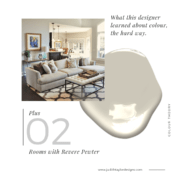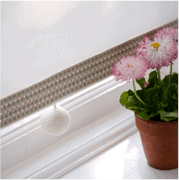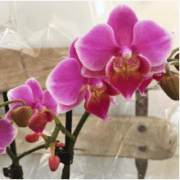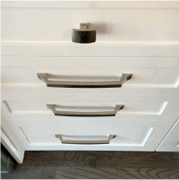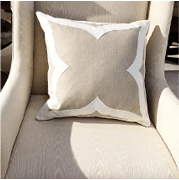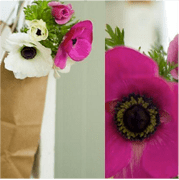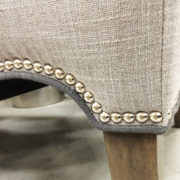Choosing all the materials for your renovation can be both stressful and overwhelming. There are many decisions to be made and if that isn’t enough, those decisions impact other decisions. We wrote about the most common kitchen countertop materials recently but those aren’t your only choices. If you are looking for something different then read on.
A great way to create interest in a kitchen is by installing one material on the perimeter cabinets, another on the island. This adds variety in a larger kitchen. But you aren’t limited to the most common materials. We have collected up the pros and cons of some less often used materials so keep reading if you want to create something unique.
Be sure and save the pin at the bottom for later if you find these pointers useful.
Don’t overlook these kitchen countertop materials
Quartzite
Quartzite is beautiful metamorphic rock that occurs naturally. It forms when sandstone is subjected to extreme heat and pressure. Like marble or granite, it is mined and sawn into slabs which later are fabricated into countertops.

Pros
Durable. Quartzite is more resilient than some of the other kitchen countertop materials. It is a lot harder than quartz, and like quartz, it can withstand some heat. Like any countertop, direct heat should be avoided so a trivet or something to absorb the heat is always advised when placing a hot pot on the countertop. The beauty of quartzite is similar to marble but with a more durable result.
Cons
Maintenance. Cleaning is simple – soap and water is all that is needed, but the sealant on these counters wears down, and must be replaced 1-2 times a year. You also need to clean spills on quartzite quickly to avoid staining.
Colour
The options in color are not as wide as quartz which has a wide array of colours and patterns. Typically they are more of a white to gray scale, but the presence of other minerals like iron and oxidization can result in pink, ochre, green, and other colours to be present.
Soapstone
Soapstone has a beautiful soft matte finish and is an aesthetic of an old-world kitchen but also has a place in a very modern installation. It is the only non-porous natural stone. It will also never harbor bacteria, is very durable and low maintenance. Unlike other natural stone it does not need a chemical sealant.
Pros
Durable. As mentioned above it is an exceptionally durable material. If you are very hard on your kitchen surfaces this would be a counter material for you, and a great choice if you have kids. It is mainly compromised of talc which gives it a smooth, almost silky feel. It is also heat resistant, leaves no fingerprints, and is resistant to staining. What’s not to love?
Cons
Softer surface. Even though soapstone is resistant to most scratches, like mentioned above it is a softer smoother feeling because of the talc. Avoid cutting directly on it and avoid heavy glass objects. This is one of its only weaknesses and many overlook them because of its beauty.
Colour
Soapstone is typically black, grey, or greenish-black. It may have veining or appear solid.
Recycled glass
With individuals seeking a unique look, some have found recycled glass countertops. There are many different variations of glass counter tops, it is important to research the choices from your local supplier.
Pros
Durable.. Glass countertops are exceptionally durable. This material will not loose its color either or break off easy, and like other countertop materials it is heat resistant. The fact that it is manufactured with recycled glass from everywhere makes you feel a bit better about where it comes from. Cleaning is also an easy procedure, just a little bit of soap and water is needed. It is nonporous which is great choice, because of this, bacteria growth will not be an issue.
Easily configured. Glass can be shaped into almost any configuration, the style, size, color and textural aspects are all a part of the configuration possibilities. They can be manufactured by consumer and industrial glass fragments.
Cons
Damage.Glass is beautiful but can be damaged. If anything heavy is dropped on it such as pots can crack or chip it which like any material can be very costly to repair, the repair process for glass countertops can be very expensive. Acidic food and drinks can damage the glass surface, and watermarks can dull the surface.
Colour
Various
Stainless Steel
Stainless steel counters are used in a variety of installations, the most popular is in commercial kitchens. They not only are very durable, but they are also one of the most hygienic surfaces for food preparation.
Pros
Durable. Stainless steel is a durable material that can last for a long period if it is cared for. It will reflect artificial and natural light and their colors which can help in the application of making a space appear brighter. As a nonporous material, which helps in cleaning and bacteria prevention, one major benefit is that it is difficult to stain this surface, hence the name. Cleaning is also a breeze with warm water and soap.
Cons
Sound. Compared to butcher block, for example, this material offers no buffering for noise. Clashing and clanging of pots and pans makes for an energetic work-space if you are on the set of a celebrity kitchen show but at home, you may not find it so pleasing. Also, they are prone to scratching so you might want to use a cloth or trivet to place pots on.
Colour
One colour only
Butcher Block
Butcher block countertops are made from straight cuts of wood glued together into thick slabs to provide a very sturdy surface for preparation and cooking. There are several types of butcher block counters including: edge grain, face grain and end grain. Edge is the most used grain type, its strong, stable, and less expensive. Face is constructed from boards that are laid flat, full widths forming a surface, is susceptible to marks and cutting. End grain is made from small rectangular blocks arranged, so that the ends are visible on the surface, it is a great for cutting surfaces since it hides the knife marks.
Pros
Wood types are endless. They can be constructed from just about any wood although maple is a popular option. Its hard and has a clear grain, cherry and red oak offer a beautiful appearance as well. Sustainable options are also available in bamboo as well.
Great cutting surface. It works very well as a cutting surface. This time-honoured material has been used for an exceptionally long time by many different professionals. It can last if it’s cared for and well maintained. It can also be repaired in some cases.
Wood does have a natural antibacterial and antimicrobial property.
Cons
Sealants. Need to be used to keep the wood in good working shape including. It is not recommended to use an unsealed butcher block near a sink, over time it can rot. The block should be oiled every six months to keep the wood protected.
Damage. These countertops are damage-prone; they can be damaged by heat and can be stained. The material can also shrink and swell depending on the humidity in the air which may cause it to crack.
Cleaning. It is not the easiest surface to clean. Many of the cuts and scratches left behind by cutting can be sanded out and sealed over but can be time consuming.
Colour
It offers an incredibly beautiful tone rich color and warmth to the space, its also easier on delicate materials such as glassware. Can be mixed with other surfaces such as marble and quartz to create a beautiful look.
Every kitchen countertop material has its own unique use and proper fit depending on your use and its function in the space. Aesthetics play a large role in how we pick our finishes in kitchens, but when we do the proper research it can be surprising based on budget what some alternative options can be, none-the-less each counter material is beautiful in the right setting.
I know my personal favourites are quartzite, soapstone, marble, and quartz but there is a place for every one of these. What are your favorites?















